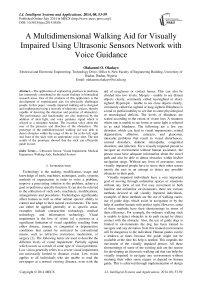A Multidimensional Walking Aid for Visually Impaired Using Ultrasonic Sensors Network with Voice Guidance
Автор: Olakanmi O. Oladayo
Журнал: International Journal of Intelligent Systems and Applications(IJISA) @ijisa
Статья в выпуске: 8 vol.6, 2014 года.
Бесплатный доступ
The application of engineering practices in medicine has immensely contributed to the recent findings in biomedical research areas. One of the products of this application is the development of sophisticated aids for physically challenged people. In this paper, visually impaired walking aid is designed and implemented using a network of ultrasonic sensors, thereby capable of detecting the direction and position of obstacle(s). The performance and functionality are also improved by the addition of alert light, and voice guidance signal which is relayed to a miniature headset. The recorded voice alerts the user of the presence and direction of the obstacle(s). The prototype of the multidimensional walking aid was able to detect obstacles within the range of 0m to 1m at the left, right and front of the stick with an appropriate voice alert. The test results of the prototype showed that the stick can efficiently guide its user.
Ultrasonic Sensor, Visual Impairment, Medical Equipment, Walking Aids, Embedded System
Короткий адрес: https://sciup.org/15010592
IDR: 15010592
Список литературы A Multidimensional Walking Aid for Visually Impaired Using Ultrasonic Sensors Network with Voice Guidance
- Arditi, A and Rosenthal, B. (1998) .Developing an Objective Definition of Visual Impairment. Proceedings of the International Low Vision . pp. Pp 331-334.
- Nicholas, Allan1995. Why Use the long Cane. 1st Edition. s.l. : Dexter,.
- Virtual Walking Stick for the Visually Impaired. [Online] 2010. http://contest.techbriefs.com/2012/entries/medical/2746.
- Omolayo, A (2011). Design and Construction of a Multidimensional Sensor Blind Man Stick. Electrical and Electronic Engineering, University of Ibadan.. B.Sc Project.
- Kang, Sung Jae, Young Ho, Kim and Moon, In Hyuk (2001) Development of a mechatronic blind stick.. Seoul, Korea : s.n., 2001. Proceedings of the 2001 IEEE International Conference on Robotics & Automation. pp. Pp 3209-3213.
- Dambhare, Shruti and A.Sakhare. (2011) .Smart stick for Blind: Obstacle Detection, Artificial vision and Real-time assistance via GPS . 2nd National Conference on Information and Communication Technology (NCICT) . pp. Pp 31-33.
- Shrivastava, K., Verma, A. and Singh, S. P. (2010) Distance Measurement of an Object or Obstacle by Ultrasound Sensors using P89C51RD2 ., International Journal of Computer Theory and Engineering,, Vol. 2.
- Wahab, Mohd Helmy Abd, et al. (2011),Smart Cane: Assistive Cane for Visually-impaired People. IJCSI International Journal of Computer Science Issues, Vol. 8.
- DIVYA, SRIRAMA, et al. (2010) Ultrasonic and voice based walking stick for the blind. Department of Electronics and Communication Engineering, Gokaraju Rangaraju Institute of Engineering and Technology.
- Novelline, Robert. (1997) Squire's Fundamentals of Radiology. 5th Edition. s.l. : Harvard University Press,. pp. Pp. 34-35. ISBNO-674-83339-2.
- Bruno, Pollet. (2012). Power Ultrasound in Electrochemistry: From Versatile Laboratory Tool to Engineering Solution. : John Wiley Sons, 2 ISBN1119967864.
- Corso, J. (1963) Bone-Conduction Thresholds for Sonic and Ultrasonic Frequencies., Journal of the Acoustical Society of America, Vol. 35.
- Takeda, S, et al. 5, (1992). Age Variation in the Upper Limit of Hearing., European Journal of Applied Physiology, Vol. 65.
- Art, Popper and Richard, R, Fay. (1995) Hearing by Bats Handbook of Auditory Research. : Springer,
- Belote, Larry (2006). Low Vision Education and Training: Defining the Boundaries of Low Vision Patients. A Personal Guide to the VA Visual Impairment Services Program..
- DIVYA, SRIRAMA, et al (2010). Ultrasonic And Voice Based Walking Stick for the Blind. Gokaraju Rangaraju Institute Of Engineering And Technology. 2010.


